Water quality and the preservation of water resources are among the top reasons that designers become environmentalists. Professionals design to reduce, recycle and reuse water. They know that drinking water is a nonrenewable resource and water use impacts many aspects of building design, including energy consumption. Most designers already know that they can reduce water by using low-flow fixtures. Some are experimenting with gray water reuse and recycling within a building as well as for irrigation. A select few are beginning to understand the impact of source water, with its increasingly complex mix of minerals, contaminants and pollutants, on building systems.
Buildings are part of a natural hydrologic cycle. The flow of water through the built environment can greatly influence water quality and harm plumbing and heating systems. Designing for zero waste, zero energy, gold, platinum, zirconium rating systems and beyond, architects and engineers have focused a lot of attention on using nature as a guide for environmental design. What if nature needs nurturing?
Water contains common elements, among which are ions of calcium, magnesium, potassium and sodium. The problem with water is that high concentrations of calcium and magnesium contained in the water can cause scale to form on pipes and water heating equipment. Scale increases maintenance and causes premature mechanical failures resulting in as much as a 24 percent loss in energy efficiency in water heaters.1 A common early method of water conditioning used ion exchange or softening as a means to control scale. However, these systems execute regeneration cycles that discharge water and brine as waste, causing an environmental problem for natural water systems. In parts of California, Michigan and other states, policy regulations that protect the water supply include the ban of water softeners that use salt to regenerate. These policies mean that new forms of water treatment needed to be more environmentally sensitive, friendlier to the environment and free of chemicals, salt and waste discharge.

Photo courtesy of Watts
Physical water treatment systems (PWT) are alternative or unconventional ways to treat water in order to prevent the damage caused by hard water scale. The advantages of these technologies are that they help the environment. They do not include a salt regeneration or discharge into the wastewater systems. PWT technologies are based on a variety of ways to transform water molecules through magnetic, electrostatic, capacitive, catalytic, or by transforming hardness into a non-scale forming microscopic crystal through template-assisted crystallization. Among the physical water treatment systems, media-assisted crystallization (MAC) excels in scale prevention and meets even the most stringent environmental standards.

Photo courtesy of Mark Chalom and Betty Tsosie
The Sleeping Rainbow Ranch Environmental Research Station is designed to be off the grid and conserve water. Media-assisted crystallization water conditioning provided the solution to a complex requirement for energy-conserving, non-polluting water treatment.
Physical water treatment systems (PWT) are alternative or unconventional ways to treat water in order to prevent the damage caused by hard water scale. The advantages of these technologies are that they help the environment. They do not include a salt regeneration or discharge into the wastewater systems. PWT technologies are based on a variety of ways to transform water molecules through magnetic, electrostatic, capacitive, catalytic, or by transforming hardness into a non-scale forming microscopic crystal through media-assisted crystallization. Among the physical water treatment systems, media-assisted crystallization (MAC) excels in scale prevention and meets even the most stringent environmental standards.
Greg Reyneke, CWS-VI, general manager at Intermountain Softwater, recommends a smart design approach to water quality and water management in building design. He has been involved in water treatment for nearly 30 years. He proposes a layered approach to the design of water systems and recommends that the first step for any project designer is to test water quality and determine how to condition the water for use. “Due to economic and environmental concerns, a multi-layered approach is necessary to provide the best balance of performance and cost while satisfying the needs of the customer. Water conditioning using media-assisted crystallization provides the most environmentally friendly solution for the prevention of hard water scale in commercial and residential buildings.”
This article will focus on media-assisted crystallization (MAC) water conditioning systems and current research that demonstrates the effectiveness of MAC to prevent scale without degradation of the water quality. The driving force for MAC in the marketplace was to offer to design professionals a green technology that would:
- Reduce scale and the negative effects of hard water
- Save energy
- Require no discharge water, regeneration, wastewater or disposal costs
- Have zero pollution
- Minimize capital investments, ongoing maintenance and operational costs
MAC is primarily used to minimize the problems associated with hard water in distribution systems, appliances and equipment that generate or use hot water. All PWT systems claim to utilize technologies that influence the physical characteristics of the solution being treated. By using MAC, scale reduction is accomplished without removing or adding anything to the water. The result is water quality that is rich in beneficial minerals while the properties that produce scale are rendered harmless.

Photo courtesy of Watts
This large hotel in Key West, Florida, protects its mechanical system from scale and premature failure with a MAC water conditioning unit.
Using a MAC water conditioning system is the first step in sustainable planning for green building ratings. Environmental benefits include:
- Reduction of pollution from wastewater in buildings
- Reduction of water use from 20 to 30 percent in buildings as there is no back washing, no regeneration, no brine fill or brine rinse as compared to conventional commercial water softeners
- Reduction of mechanical room size because of smaller tanks and the lack of a need to store salt, a non-renewable resource
- Prevention of scale accumulation on equipment and piping, which maintains peak energy efficiency, reduces water use and eliminates costly equipment cleaning
MAC systems are over two-thirds smaller than conventional water conditioning systems and there is no need to purchase or store salt. Many water experts are using MAC as the first line of defense against harmful scale in both new and existing buildings. They are receiving credits in green building rating systems because of the environmental advantages of MAC.
For some projects, an evaluation of uses in the building may require a number of techniques that will condition, filter and soften water as necessary. Although Reyneke recommends starting treatment with MAC water conditioning, he has paired this technology with additional water filters for total water technology management. After MAC, water may be engineered to flow to separate water “zones,” plumbing utility grade water to some areas of the building to use for fire suppression or toilet flushing, while treating others with carbon filters for drinking water.
Keith Karl, president of Water Resources Group, also recommends a hybrid approach to water system design and for water treatment at the National Gallery of Art in Washington, D.C., discussed in a later case study, combining MAC with environmental friendly sand filters and ultra-violet light. MAC combined with a complete water conservation plan can be important for designers who want to save water, energy and improve water quality.
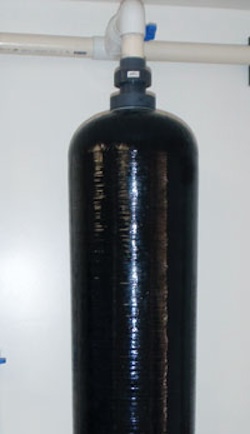
Photo courtesy of Greg Reyneke, CWS-VI
This MAC unit installed at Sleeping Rainbow Ranch Environmental Research Station does not require electricity and uses very little space.
Capitol Reef National Park is located in the Waterpocket fold of South-central Utah. (Waterpockets are basins that form in exposed sandstone layers scoured by water.) This National Park is rich in red rocks with striated layers and a monocline, a steep, raised cliff that exposes the rich geologic history of the area for over a hundred miles. The Sleeping Rainbow Ranch Research Station is located in the heart of this area and counts among its resources numerous native plants, mammals, birds, reptiles, amphibians and fish. The water that scoured the rocks is now buried underground and drawn from a well for the renovation of the Sleeping Rainbow Ranch Environmental Research Station.
In 2009, architect Mark W. Chalom, LEED AP, designed new buildings for the station to maximize sustainability and preserve the scarce water resources and maximize solar energy. For Chalom, this meant that his staff researched and tested many alternatives from solar thermal hot water to low-flow showerheads. The program requirements for the building included the design of a water system for five buildings with 15 solar showers per building and a large fire suppression system.
When evaluating water supply for Sleeping Rainbow Ranch Environmental Research Station Greg Reyneke, CWS-VI, general manager at Intermountain Softwater, consulted with the architect, the National Park System and Utah Valley University to evaluate the existing water supply to find a solution to the problems that the mineral rich well water posed for the use of all of the water systems.
Due to the isolation of this facility, the owners required on an off-the grid solution designed for water conservation and energy efficiency. A comprehensive water analysis was made from the source water and samples found that even though the site was "pristine" the well water quality was not. Contaminants in the water included high levels of:
- Calcium carbonate which although not harmful for human consumption was of the level of hard water that would be prone to scaling and damaging to equipment
- Iron and manganese which causes serious staining issues
- Sulfate which has a laxative effect upon consumption as well as causing premature failure of water-using appliances
- Manganese which can cause additional staining
- Total dissolved solids (TDS) at such a high level of conductivity that can cause unpleasant taste, accelerating wear and tear on water-using appliances like water heaters and humidifiers
The owners and operators of the facility stipulated that no chemicals could be discharged through drainage systems on the site. The well was driven by intermittent solar power with no battery backup. There was irregular water pressure and flow rates among other complex and difficult issues that had to be faced by the designers who ultimately separated fire suppression systems from the well water and used a nitrogen system as an alternative.
The design water criteria for the project was not simple: provide the quantity of water required with the quality of water compliant with U.S. EPA and state of Utah primary drinking water standards. In addition, the system needed to minimize maintenance and capital costs. The solution included a layered approach to piping, water zoning and water distribution which began with a media-assisted crystallization (MAC) water conditioning unit. By flushing water through the MAC unit before storing the water in the tank, the engineers were able to treat the water so it would not create scale, which could clog piping, solar heaters and other equipment and fixtures throughout the campus.
By treating the water through a hybrid approach, the effect of MAC water conditioning along with a carefully planned nanofiltration system provided a reduction of the harmful elements from the natural water source and water treatment to the level of safe drinking water standards.
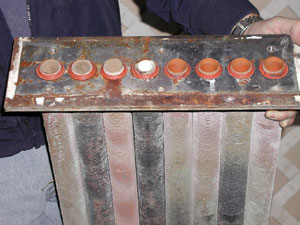
Photo courtesy of Watts
Example of tube bundles from a water heater where scale accumulation caused a single tube to block and burn out the bundle prematurely.
Hard water is not a health problem. In fact, the National Research Council (National Academy of Sciences) states that hard drinking water generally contributes a small amount toward total calcium and magnesium human dietary needs. They further state that in some instances, where dissolved calcium and magnesium are very high, water could be a major contributor of calcium and magnesium to the diet. Hard water is desirable for its mineral richness that benefits human health as well as a problem that can cause scaling on plumbing pipes and equipment in buildings. Hard water also interferes with a variety of cleaning processes, can stain equipment and may even have a stronger taste and smell than soft water.
As with most sustainability issues, water and building problems depend on where the building is located and the quality of the source water, the cold water that comes from either a well or a municipality to a building is a chemical mix of minerals, among these: calcium ions (Ca2+), magnesium ions (Mg+2) and bicarbonate ions (HCO3-). Hardness is a component of the total dissolved solids measured by the amount of calcium and magnesium in the water. The Water Research Council classifies measures of water hardness based on quantities calcium and magnesium. (See Sidebar.)
Scale is a mineral compound consisting mainly of calcium or magnesium carbonates in hard water. Scale can damage plumbing, appliances and other equipment. Accumulation of scale in water heating equipment causes a steady drop in efficiency and ultimately costly maintenance or worse, the need for replacement. Hard water effects in the home or apartments include:
- Spotted dishes from the dishwasher
- Soap scum deposits from an inability for soap to lather
- Scale formation on faucets and showerheads
- Scale accumulation in plumbing pipes
- Scale formation on appliances
- Losses of efficiency
- Higher costs of maintenance
- Shorter life of equipment
- More time cleaning
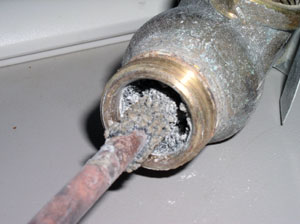
Photo courtesy of Watts
Example of scale build-up on a water heater's temperature and pressure valve. Scale can lead to malfunctions and potentially dangerous explosions of heaters with clogged pressure valves.
Scale accumulation in water heaters can lead to an increased energy usage by up to 24 percent.
The problem of scale in commercial buildings has an exponential impact on maintenance. Scale can cause the premature replacement of equipment. Hard scale can accumulate over time on pipes, valves, fixtures and heating elements causing a multitude of problems. Scale deposits are insoluble making scale extremely difficult to remove. Once formed, scale often leads to costly remediation efforts. As scale forms, it reduces the inner diameter of pipes causing restrictions in flow rate and pressure loss problems in mechanical systems. Scale often becomes encrusted on the internal moving parts of valves and components potentially causing safety failures. For example, in a boiler or hot water tank, heating elements that become coated with scale reduce system efficiency and increase operating costs for end users. Reducing the impact of scale on mechanical systems affects the energy use of the building and is part of an integrated sustainable design strategy for buildings.
Determining Water Hardness
|
|
The Water Research Council classifies water supplies based on how many grains of hardness per gallon of water (g.p.g.) Measurements by grain dates to the Bronze Age as a unit of measured mass roughly based on the mass of a single seed of wheat. The chart below lists the classifications used to determine water hardness or softness.
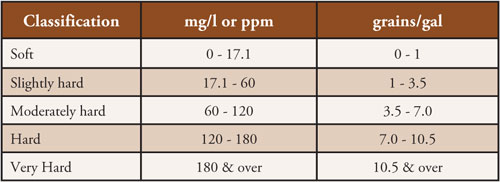
General patterns of hardness in the United States can be found on a map developed by the U.S. Geological Survey and a map can be found on their website.2 The softest waters are found in parts of New England, the South Atlantic-Gulf States, the Pacific Northwest, and Hawaii. Moderately hard waters are common in many rivers of Alaska and Tennessee, in the Great Lakes region, and the Pacific Northwest. Hard and very hard waters were found in some streams in most of the regions throughout the country. Hardest waters (greater than 1,000 mg/L) were measured in streams in Texas, New Mexico, Kansas, Arizona, and southern California. Information on how to find out about local drinking water quality can be found on the EPA website.3
|
Solutions That Cause Environmental Challenges
Although some areas of the United States have naturally soft water sources, the most plentiful sources of fresh water are rich in minerals and can be classified to varying degrees of hardness. Conventional treatments include the installation of a water softener that removes the hard water minerals that can cause scaling. Unfortunately, softening typically causes a poor taste in the water and elevates the sodium level of the treated water, which may be a health issue for some people. Water softening is not the same as MAC. Softening is a process that removes scale forming calcium and magnesium hardness ions from water and replaces them with non-scale forming sodium ions through a process known as ion exchange. Periodically the softening system must regenerate itself with a sodium chloride brine solution to restore its sodium ion content thus allowing further softening to take place.
Ion exchange water softeners discharge brine elevated in calcium, magnesium and chlorides into wastewater systems increasing the challenges and costs of water re-use. Although effective in controlling scale formation of water delivered to the consumer, discharge from these systems results in elevated levels of salt deposited back into the environment. Water flushed from these systems has high concentrations of salinity in their total dissolved solids (TDS), which consequently affects the purity of the fresh water supply. This is causing a crisis for communities that have seen a rise in the costs for water treatment because of this common practice.
Water Quality and Water Reuse
|
|
TDS (salinity) is a measurement of total dissolved solids in water including inorganic (hardness, salts) and organic substances (pesticides, herbicides, etc.). The sources of salinity in water include:
- Natural minerals in rocks found in lakes, rivers, streams and aquifers
- Water from natural salt springs that enter into rivers, lakes and streams
- Agricultural fertilizers that drain from fields into rivers, lakes, streams and aquifers
- Water treatment chemicals such as chlorine that make water safe for human consumption
- Home water treatment systems, like water softeners, that treat water for hardness
- Cleaning chemicals
- Foods
Water reuse is a water conservation practice in which reclaimed water is used for a direct beneficial purpose. As examples, Arizona researchers identified the effect of TDS on water reuse to agriculture and to buildings. TDS can affect crop salt tolerance and yields and increase the need for additional water for irrigation to flush salts from root zones. It can also increase water usage by cooling towers and cause energy loss and equipment damage due to scaling.
|
MAC Media
A specially designed catalyst is coated on the surface of the MAC media which reduces bicarbonate. This reduction in bicarbonate causes calcium and magnesium to precipitate out of the water as nano-sized particles before they can grow into scale.
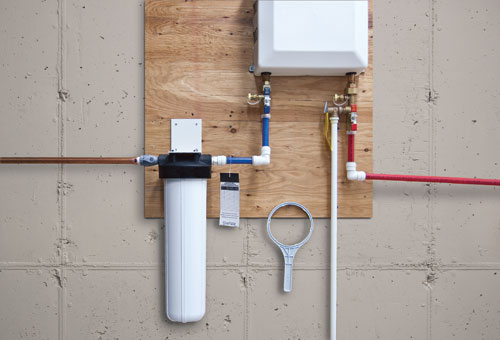
Photo courtesy of Watts
Media-assisted crystallization water conditioners are ideal for protecting tankless hot water heaters. This image demonstrates the copper connection from the water source through the MAC unit and into the heater.
This process of water conditioning results in the creation of what might be considered “soft scale.” These nano-sized microscopic crystals of scale (seed crystals), rapidly form in the treated water, not on the contact surfaces of the water system, and are carried downstream in colloidal suspension through the water system.
- In untreated water, the scale forms on the inside walls of pipe, exterior of fixtures and all heating surfaces.
- In MAC treated water, the seed crystals themselves provide a far greater surface area for new scale formation. Therefore, new scale preferentially deposits on this continuously replenished stream of suspended crystals rather than on the water contact surfaces—especially those surfaces that are at elevated temperatures and ultimately flow down the drain.
Preserving the Nation’s Artwork: Sustainable Water System Planning and System Integration
|
|
The National Gallery of Art in Washington, DC, is a sprawling complex of buildings, underground tunnels and landscape gardens. The West wing of the galleries was designed by John Russell Pope in 1941 and is connected by an underground tunnel to the award winning East Wing, designed by I.M. Pei in 1978. Visitors to the galleries lunch in part of the underground building in front of a large, exposed water fall little knowing that this symbolic fountain also represents a complex interaction of nature with the built environment. The buildings, adjacent ice rink and gardens are engineered to use water for many multi-layered purposes.
When the East Wing was built, the water system was re-engineered for both buildings. Bulk water from the DC water supply was piped to makeup water loss in their large chilled water system. Chilled water is used in air washers for temperature control and humidification throughout the gallery. Historically a non-chemical treatment approach was used on the bulk chilled water with concern to protect the fragile and valuable artwork in the buildings.
Twenty years later, to address maintenance concerns that included the accumulation of scale and pipe corrosion, engineers began to investigate 21st century alternatives to find the best environmental alternatives for water quality while continuing to protect their concerns for air quality. According to Keith Karl, the president of Water Resources Group, the unique challenges of this project required a multi-layered approach to the design of the water conditioning system. After analyzing the source water from the D.C. water supply and the bulk circulating chilled water, their team realized that they could not use conventional treatments for biological contaminants, corrosion and scale because of the fear of having chemical fumes in the air stream for the gallery.
After extensive research, they chose a media-assisted crystallization (MAC) water conditioning system to be installed on the incoming city water used to makeup the chilled water supply. This new product excels in the prevention and removal of scale, by incorporating a technology similar to a biomechanical process, to control scale formation, without the use of chemicals and without the waste typically needed by systems that have to regenerate. The MAC system was smaller than conventional water conditioning or softening units and requires very little maintenance. A MAC system transforms the dissolved calcium in the hard City water as it is introduced into the building, into harmless calcium carbonate particles.
As a preliminary study of the effectiveness of a MAC water conditioning system, engineers piloted a 30-day study on one of the air washers. They tested for water quality, odors and calcium carbonate scale. In this trial, all aspects of water quality improved and there was an immediate and estimated twenty percent reduction of scale. This test led to the engineering of additional systems that include the large lunchroom waterfall as well as conditioned water delivered to the ice skating rink and HVAC comfort cooling system.
All of the water for the complex is treated to reduce scale. In addition, as part of a multi-layered approach to water conditioning, microbial sand vortex filters and ultraviolet treatments condition water for additional high-use areas in the facilities to assure the removal of all biological contaminates. This sustainable approach allows for specific water treatments by use in the facility. The MAC unit requires less space and has the environmental advantages of reducing maintenance costs while increasing the longevity of the plumbing system. The MAC system has also improved energy efficiency of the mechanical equipment and lowered energy costs.
|
Scale formation is not static (it is constantly forming and dissolving). The existence of continuously generated seed crystals not only eliminates further deposition of scale on water contact surfaces but in fact will cause deposited scale to gradually dissolve back into the water and deposit on passing seed crystals in the water (from contact surfaces to solution to seed crystals). This means that not only are MAC water conditioning units good for new construction, these systems can also help alleviate scale problems in existing buildings including historic structures. When using MAC in new construction, Reyneke recommends that new copper piping should be allowed to cure or oxidize for a minimum of four weeks before turning on the water conditioner. This prevents the leaching of copper from the new pipes which can damage the MAC media. Water quality evaluation and treatment options for complex mechanical systems may require assistance from manufacturers who can design the MAC interface as required.

Chart courtesy of Arizona State University study April 26, 2011
As shown on the chart, results from current research demonstrate that MAC is the most effective water conditioning system for the reduction of scale.
Research to Set Environmental Benchmarks
The University of Arizona, along with HDR Engineering Inc. conducted a recent research study sponsored by the WateReuse Foundation that evaluated alternatives to domestic ion exchange water softeners.4 The participants of the study included the California cities of Hollister, Los Angeles, and Santa Clara County and water samples were also tested in Arizona cities including Phoenix, Tucson and Scottsdale. The goal of the study is to review technologies that would provide consumers with the ability to reduce the impacts of hard water without creating the negative impacts of salt and brine backwashes into the environment. It also developed and used testing methodology based on German standards to set metrics for the measurement of the effectiveness of scale prevention. The study was commissioned because of the urgency of the problem of poor water quality in freshwater resources. More and more communities have struggled with the cost and environmental impacts of the rising concentration of TDS and associated ions and salts in wastewater collected and received at water reclamation facilities.
Presently, there are no ANSI or NSF standards for testing water quality and scaling. The German Society of Gas and Water Specialists (DVGW), which regulates water quality in Germany, developed a protocol that measures anti-scaling of water conditioning devices.5 The Arizona study used a testing protocol based on the DVGW W512 test to assess the control of scale formation. The process was to pump 130 L/d of water through an electronically heated 10-L reservoir for 20 days. After the test was completed, researchers determined the quantity of scale formed on the heating element and the reservoir. Baselines were set for certification of conditioners for the prevention of scale. The study evaluated several no-salt alternatives to ion exchange and measured the mechanisms and effect on these physical water treatment (PWT) systems to the accumulation of scale. These systems included:
- Capacitive Deionization (CDI)
- Electrically Induced Precipitation (EIP)
- Electromagnetic Water Treatment (MAG)
- Media-Assisted Crystallization (MAC)

Photo courtesy of Watts
Media-assisted crystallization water conditioning systems use a process similar to biomineralization creating "soft" scale crystals that do not attach to plumbing components, or mechanical equipment.
The most familiar PWT devices operate either through magnetic or electronic fields but according to the latest studies, MAC devices are the only product that meets and exceeds the latest measurement standards. Although there was a significant reduction in scale for all PWT devices, the scale prevention of the media-assisted crystallization device excelled and performed substantially better than all of the others.
Improving Water Quality in Cities
According to Steven Solomon in Water, The Epic Struggle of Wealth, Power and Civilization,6 earth as the water planet is like humans, comprised of about 70 percent water. Because of the nature of the hydrologic cycle, the water on earth is a constant quantity, however, the quality of water has been greatly impacted by humans and drinking water is a nonrenewable resource. He outlines the intense and interrelated ways that water is used by humans for drinking, cooking, sanitation, agriculture, industry, mining, power, transportation and of “growing prominence today, environmentally to sustain vital ecosystems against natural and man-made depletions and degradations.” According to Solomon, “The secret of water's extraordinary potency to transform history was that whenever a society, in its constant struggle to wrench a surplus from nature, was able to innovate to make its water resources more manageable, abundant, potable or navigable, it...unlocked and harnessed more of water's inherent, often hidden catalytic potential for growth.”7
Across the world, protecting water resources and improving water quality has become a major political and strategic focus. Fresh water and treated water is a miraculous combination of minerals, nutrients and chemicals that give life on this planet. Aquifers, wells, rainwater, water trapped and treated in sewage plants can provide both helpful and harmful nutrients depending on the composition of the water chemistry. Water, as many pundits have stated, is the next oil crisis. The lack of fresh water resources needed to fuel humans, agriculture and industry is under scrutiny by citizens and politicians. Water conditioning that adds harmful salt brine to the water system only adds to the problems of poor water quality. If humans are the enemy of fresh water resources, they must also be the source of the solution through applied knowledge, invention and action.
Water conservation is also a major environmental issue when designing a sustainable building. Using MAC conserves water while increasing energy efficiency. The use of a media-assisted crystallization conditioner is part of a smart, 21st century, integrated environmental strategy for water use in buildings.

Photo courtesy of Watts
Diagram comparing size of MAC units to conventional softeners with salt storage.
Endnotes
- http://www.wqa.org/detergent/SWB_Studies.pdf
- http://water.usgs.gov/owq/hardness-alkalinity.html
- http://water.epa.gov/drink/local/index.cfm
- http://www.usbr.gov/research/AWT/WateReuse/WateReuse_research.html
- http://www.wcponline.com/pdf/0702Tech%20Talk.pdf
- Solomon, Steven. Water, The Epic Struggle for Wealth, Power and Civilization. Harper Perennial, N.Y., 2011.
- Solomon, p.18.
Architect Celeste Allen Novak, AIA, LEED AP, specializes in sustainable design and planning in Ann Arbor, Michigan.























